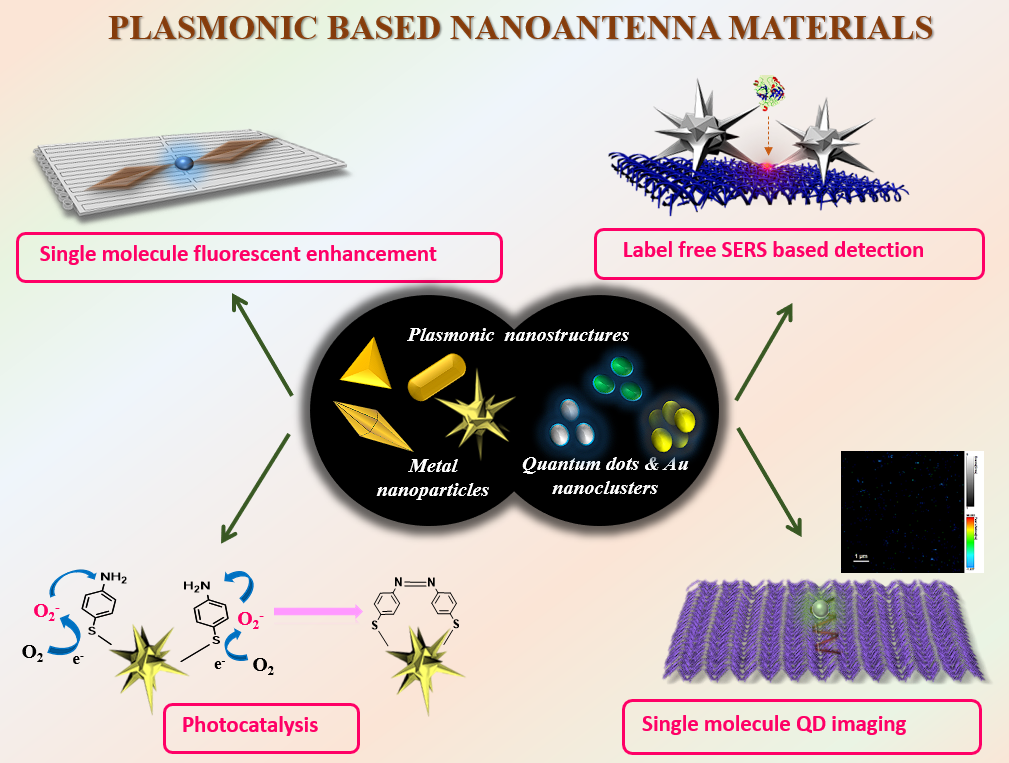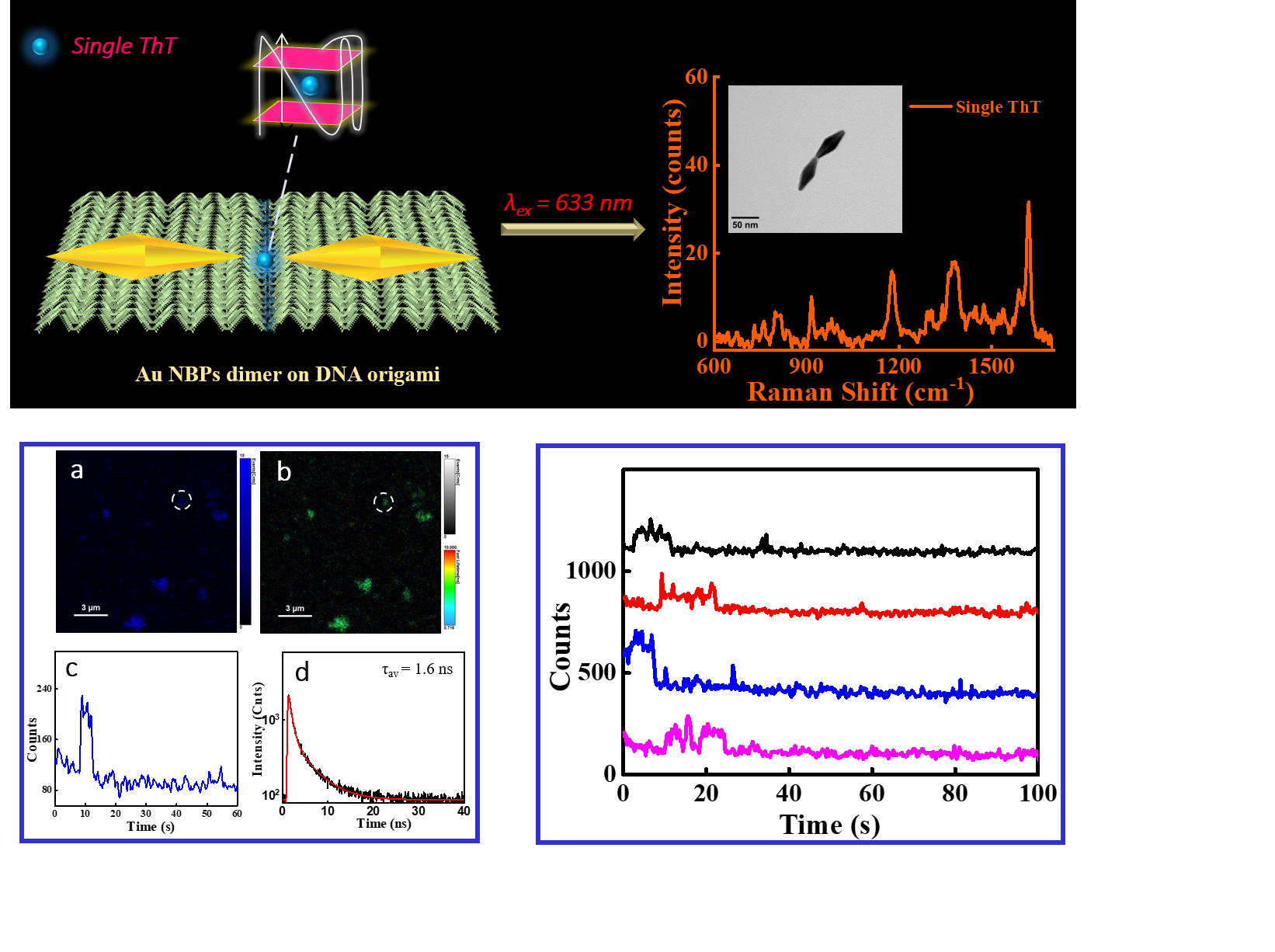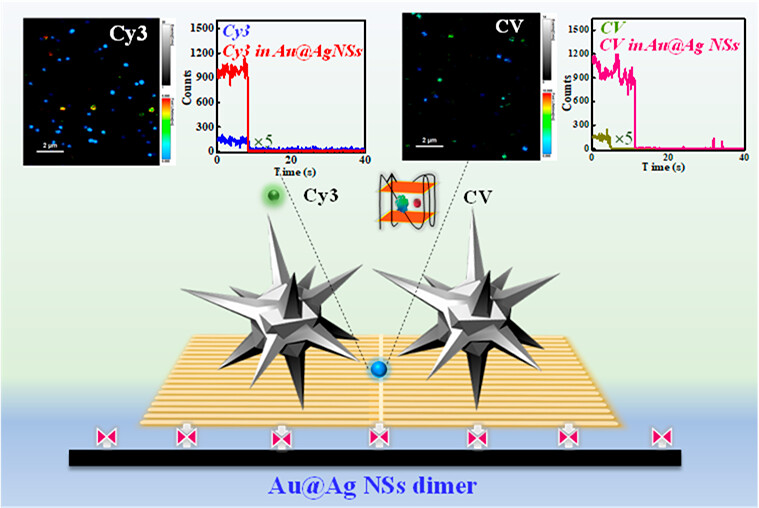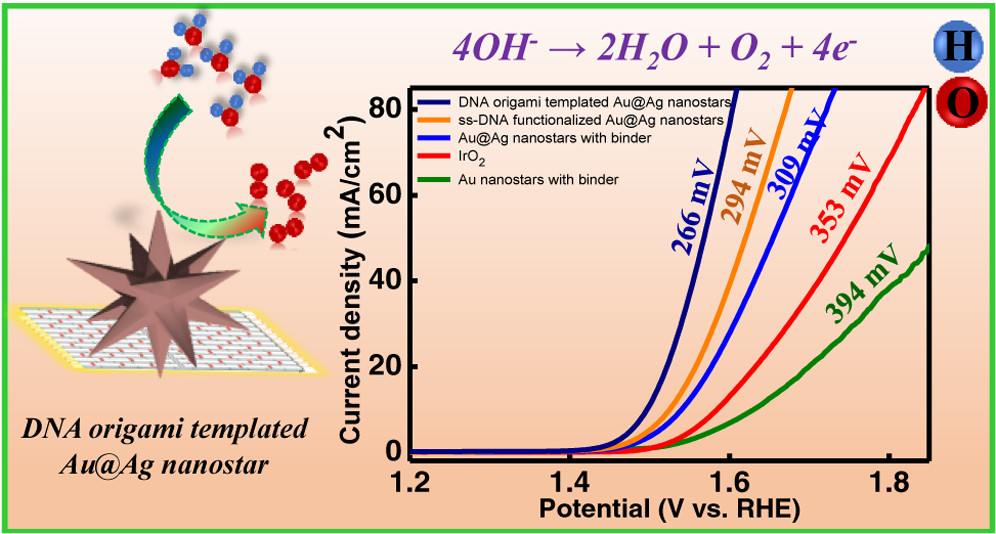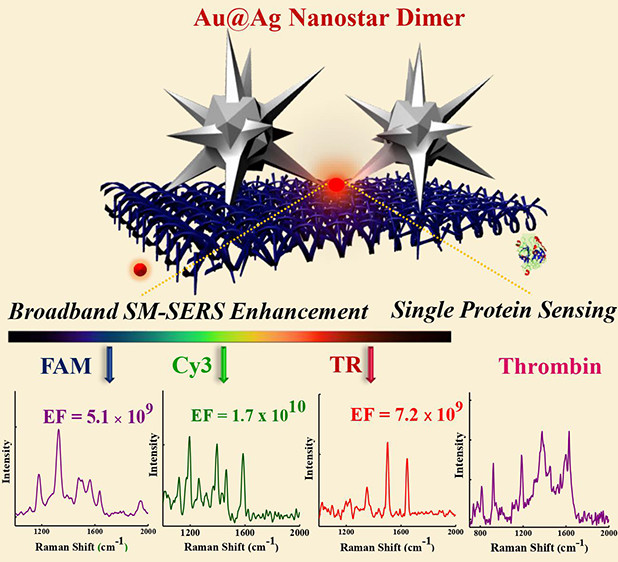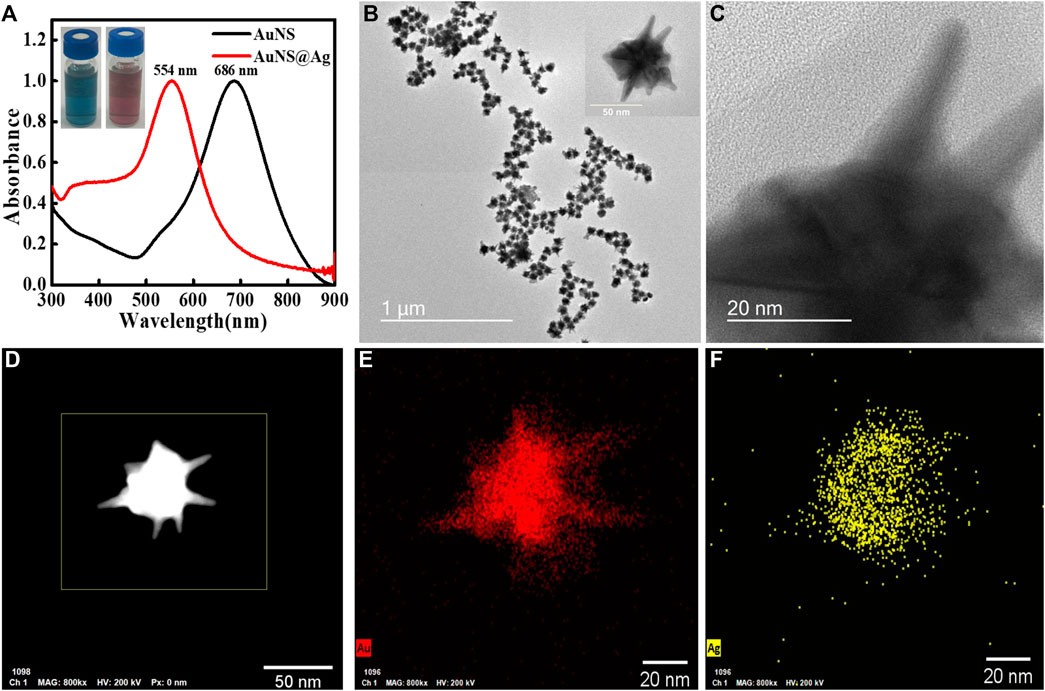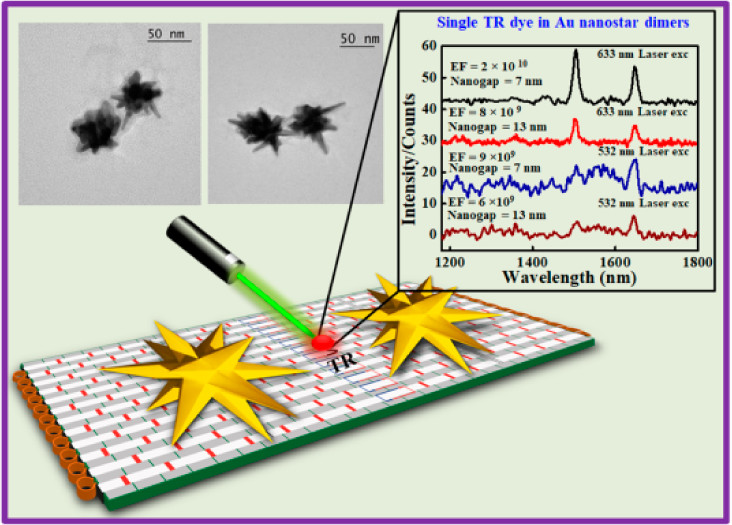Faculty Directory

Dr. Tapasi Sen
Associate Professor (Scientist-E)
Fabrication of Plasmonic nanostructures based on DNA origami, Nano-Bio-Interactions study using Single-Molecule Fluorescence Spectroscopy, Development of DNA-directed self-assembled Nanoantennas to get strong Fluorescence enhancement for biomolecular assays and sensing applications, Design of nanostructures materials with unidirectional energy transfer for developing efficient light harvesting systems.
Contact Information :
-
Email:
tapasi@inst.ac.in -
Google Link:
Google Link
-
Ph.D. positions are available in our group for students with independent fellowship like CSIR-NET-JRF, UGC-NET-JRF, DBT-JRF, INSPIRE etc.
Please contact PI Dr. Tapasi Sen through email at tapasi@inst.ac.in.
-
Fabrication of Plasmonic nanoantennas based on DNA origami.
Exploiting the unique spatial addressability offered by DNA origami, we synthesize a variety of plasmonic nanoantenna metamolecules. Anisotropic nanostructures like Silver/Gold Nanostars, Silver/Gold Nanorods, Silver/Gold Nanobipyramids, etc. are employed for the formation of nanoantennas. Plasmonic hotspots are generated at precise positions in these gold and silver dimer nanoantennas to achieve several hundred folds of electromagnetic enhancement.
-
Single Molecule Fluorescence Enhancement
Plasmonic nanoantennas provide a viable platform for emission manipulation of quantum emitters through unprecedented control of light-matter interactions in the deep subwavelength regime, substantially improving the weal emitters quantum efficiency. Nanoantenna geometries are rationally designed to realize precise engineering of metal nanostructures and deterministic positioning of a single emitter specifically at the plasmonic hotspot. This thus generates huge fluorescence enhancement enabling application of these nanoantennas as highly sensitive biosensing platforms.
-
SERS-based label-free single molecule detection of clinically relevant biomolecules.
Single clinically relevant biomarkers are precisely placed in the hotspots engineered in the plasmonic nanoantennas. Intense field enhancement is generated in the plasmonic hotspots which enable SERS-based application of the structures for single molecule detection. This can pave the way for the fabrication of highly sensitive biosensors with significant improvements in detection limits.
-
Single Molecule Fluorescence Spectroscopy
Single molecule experiments offer new perspectives to study the behaviour of individual molecules which are often concealed in ensemble measurements due to averaging out. In this direction, plasmonic nanoantennas are fabricated which can produce several folds of fluorescence enhancements of single dye molecule. Our plan is to use these highly capable nanostructures as tools in single molecule fluorescence spectroscopy to study Nano-Bio dynamics using our PicoQuant MicroTime 200 Confocal setup.
-
Photocatalysis
The novel ways to carry out chemical reactions are one of the ultimate challenges for sustainable development in modern industry. For the generation of effective light-harvesting systems and photocatalytic reactions, unidirectional energy transfer in nanostructured materials is designed. The strong light–matter interactions produce highly energetic hot electrons and holes that possess immense power for transforming light energy into chemical energy and carrying out photocatalytic reactions and single-particle photocatalysis. These energetic charge carriers are more localized at the sharp points known as hot spots or active areas.
-
DNA Origami-Template Bimetallic Core-Shell Nanostructures for Enhanced Oxygen Evolution Reaction
We presented the design of Ag-coated Au nanostar (core–shell-type Au@Ag nanostar) monomer structures assembled on rectangular DNA origami and studied their electrocatalytic activities through OER, which remains unexplored. Our designed DNA origami-template bimetallic nanostar catalyst showed excellent OER activity and high stability without using any external binder and exhibited a current density of 10 mA cm–2 at a low overpotential of 266 mV, which was smaller than those of ss-DNA-functionalized Au@Ag nanostars and DNA origami-templated pure Au nanostars. Our results revealed that DNA origami-assembled core–shell Au@Ag nanostars show better electrocatalytic performance as compared to pure-core Au nanostars immobilized on DNA origami, owing to the presence of a highly conductive Ag layer. Such controlled assembly of bimetallic nanostructures on a DNA origami template can provide additional electrochemical surface area and a higher density of active sites resulting in enhanced electrocatalysis.
More Info: https://doi.org/10.1021/acs.jpcc.2c00007
-
Broadband SERS Enhancement by DNA Origami Assembled Bimetallic Nanoantennas with Label-Free Single Protein Sensing
Plasmonic dimer nanoantennas with a tunable gap decorated with Ag-coated Au nanostars on origami were constructed. The single-molecule SERS enhancement of three dyes with emission in different spectral regions after the incorporation of single dye molecules in between two nanostars was demonstrated. The enhancement factors (EFs) achieved in the range of 109–1010 for all the single dye molecules, under both resonant and non-resonant excitation conditions, would enable enhanced photostability during time-series measurement. The potential of our designed nanoantennas was further explored to accommodate and detect a single thrombin protein molecule after selective placement in the wide nanogap of 10 nm. Our results suggest that such nanoantennas can serve as a broadband SERS enhancer and enable specific detection of target biological molecules with single-molecule sensitivity.
More Info: https://doi.org/10.1021/acs.jpclett.1c02272
-
Selective recognition of amyloid marker single Thioflavin T using DNA origami-based gold nanobipyramids nanoantenna
In our recent publication in Nanoscale, the design of gold bipyramid monomer and dimer structures with precise nanogap assembled on a rectangular DNA origami template was demonstrated for the first time. An amyloid marker ThT, a SERS‐active dye, was incorporated on DNA origami using G-rich DNA sequence modified branching staple in the junction of the origami. The stoichiometry of the ThT dye molecule bound to the G-quadruplex complex was estimated by using a single molecule fluorescence confocal microscope which suggested the presence of a single ThT molecule incorporated on DNA origami. We further utilized our designed nanoantennas for specific detection of ThT using SERS-based technique for achieving the goal of ultrasensitive detection of amyloid fibrils. Our experimental findings prove that our developed platform was able to sense a single ThT molecule through extraordinary enhancement of ThT Raman signal by the plasmonic hotspot created in the nanogap of Au bipyramid dimer nanoantennas. To the best of our knowledge, this is the first report on specific detection of single ThT using metallic nanoantennas based on DNA origami.
More Info: https://doi.org/10.1039/D2NR06389A
-
Single-Molecule Fluorescence Enhancement-Based Detection of ATP Using DNA Origami-Assembled Au@Ag Nanostar Optical Antennas
In our recent report published in the Journal of Physical Chemistry C, bimetallic Au@Ag nanostars (NSs) nanoantenna site-specifically arranged by DNA origami technique was employed for the fluorescence enhancement of a single Cy3 dye positioned at the interparticle gap between the nanostructures. A maximum of ∼65-fold enhancement of Cy3 dye was observed using fabricated dimeric assemblies of Au@Ag NSs. Additionally, to expand the utility of ultrasmall detection volumes of assembled dimer nanoantenna, the fluorescence enhancement of a small biologically relevant molecule, ATP was explored using crystal violet dye as the probe, attaining a maximum of ∼42-fold enhancement. The fluorescence measurements of the designed system using CV dye indicated the detection of ATP molecules down to the sensitivity of two molecules. The present work adds a new tool in the design of coupled nanoantennas exhibiting fluorescence enhancement and can be further developed for emerging applications in point of care diagnosis.
More Info: https://doi.org/10.1021/acs.jpcc.3c00020
Current Group Members
-
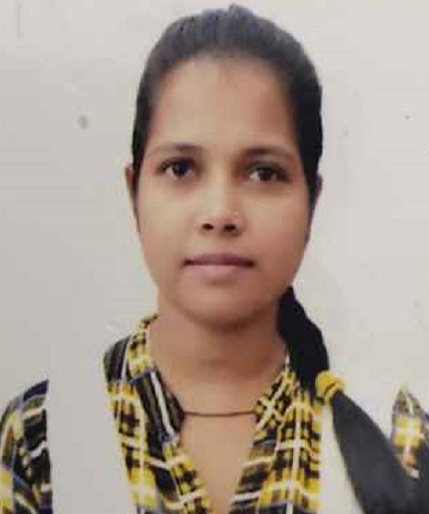
MS. PRIYANKA
Email: priyanka.ph22233@inst.ac.in
Reg. No.: PH22233
-

MS. SHIKHA RAI
Email: shikha.ph20250@inst.ac.in
Reg. No.: PH20250
-
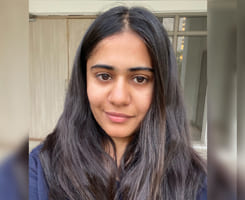
MS. MRIDU SHARMA
Email: mridu.ph20214@inst.ac.in
Reg. No.: PH20214
Alumni
-
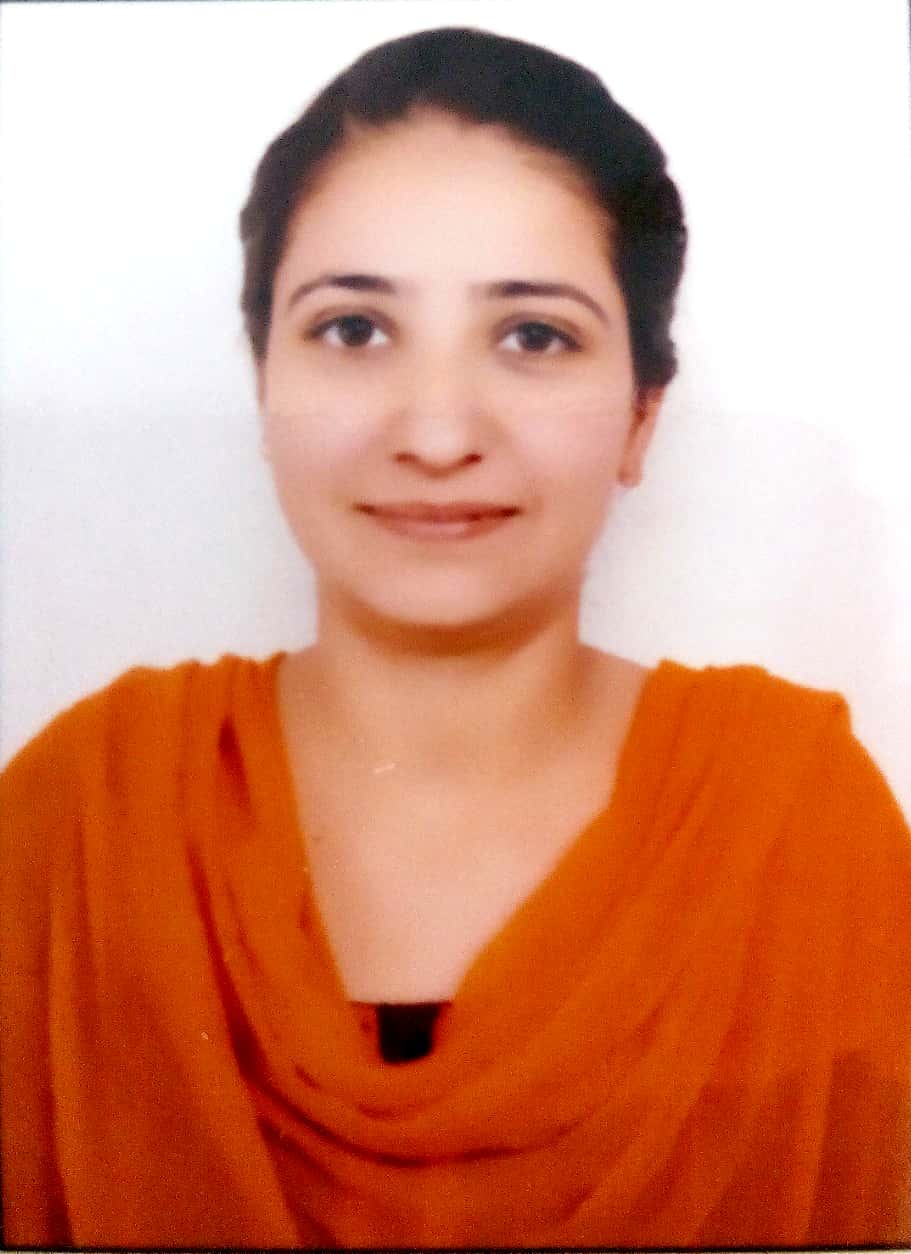
MS.GAGANDEEP KAUR
Reg. No.: PH17231
Designation: PhD Scholar
Jan 2018 - Jul 2023
-

MS. CHARANLEEN KAUR
Reg. No.: PH19204
Designation: PhD Scholar
Aug 2019 - Feb 2025
-

MS. VISHALDEEP KAUR
Reg. No.: 14-PHY-106
Designation: Post Docs/RA
Jan 2019 - Nov 2023
-

MS. SWATI TANWAR
Reg. No.: PH14212
Designation: PhD Scholar
Jul 2014 - Jun 2020
-
1.
White light emission from a mixture of silicon quantum dots and gold nanoclusters and its utilities in sensing of mercury (II) ions and thiol containing amino acid: , Swati Tanwar, Bhagwati Sharma, Vishaldeep Kaur , RSC Adv. , 9: 15997 , (2019) , 10.1039/C9RA02012H -
2.
Single-Molecule Fluorescence Enhancement Based Detection of ATP Using DNA Origami-Assembled Au@ Ag Nanostar Optical Antennas , Vishaldeep Kaur, Charanleen Kaur, Tapasi Sen , The Journal of Physical Chemistry C , 2023 , 7308–7318 , https://doi.org/10.1021/acs.jpcc.3c00020 -
3.
Selective recognition of the amyloid marker single thioflavin T using DNA origami-based gold nanobipyramid nanoantennas , Charanleen Kaur, Vishaldeep Kaur, Shikha Rai, Mridu Sharma, Tapasi Sen , Nanoscale , 2023 , 15 , 6170-6178 , https://doi.org/10.1039/D2NR06389A -
4.
Correction to Interfacial Engineering of CuCo2S4/g-C3N4 Hybrid Nanorods for Efficient Oxygen Evolution Reaction , Rathindranath Biswas, Pooja Thakur, Gagandeep Kaur, Shubham Som, Monochura Saha, Vandna Jhajhria, Harjinder Singh, Imtiaz Ahmed, Biplab Banerjee, Deepak Chopra, Tapasi Sen, Krishna Kanta Haldar , Inorganic Chemistry , 2022 , 61 , 13226-13227 , https://doi.org/10.1021/acs.inorgchem.2c02608 -
5.
DNA Origami-Templated Bimetallic Core–Shell Nanostructures for Enhanced Oxygen Evolution Reaction , Gagandeep Kaur, Rathindranath Biswas, Krishna Kanta Haldar, Tapasi Sen , The Journal of Physical Chemistry C , 2022 , 126 , 6915-6924 , https://doi.org/10.1021/acs.jpcc.2c00007 -
6.
DNA‐Origami‐Based Assembly of Au Ag Nanostar Dimer Nanoantennas for Label‐Free Sensing of Pyocyanin , Vishaldeep Kaur, Swati Tanwar, Gagandeep Kaur, Tapasi Sen , ChemPhysChem , 2021 , 22 , 160-167 , https://doi.org/10.1002/cphc.202000805 -
7.
Interfacial design of gold/silver core–shell nanostars for plasmon-enhanced photocatalytic coupling of 4-aminothiophenol , Gagandeep Kaur, Swati Tanwar, Vishaldeep Kaur, Rathindranath Biswas, Sangeeta Saini, Krishna Kanta Haldar, Tapasi Sen , Journal of Materials Chemistry C , 2021 , 9 , 15284-15294 , https://doi.org/10.1039/D1TC03733A -
8.
Interfacial Engineering of CuCo2S4/g-C3N4 Hybrid Nanorods for Efficient Oxygen Evolution Reaction , Rathindranath Biswas, Pooja Thakur, Gagandeep Kaur, Shubham Som, Monochura Saha, Vandna Jhajhria, Harjinder Singh, Imtiaz Ahmed, Biplab Banerjee, Deepak Chopra, Tapasi Sen, Krishna Kanta Haldar , Inorganic Chemistry , 2021 , 60 , 12355-12366 , https://doi.org/10.1021/acs.inorgchem.1c01566 -
9.
Broadband SERS enhancement by DNA origami assembled bimetallic nanoantennas with label-free single protein sensing , Swati Tanwar, Vishaldeep Kaur, Gagandeep Kaur, Tapasi Sen , The Journal of Physical Chemistry Letters , 2021 , 12 , 8141-8150 , https://doi.org/10.1021/acs.jpclett.1c02272 -
10.
DNA Origami-Templated Bimetallic Nanostar Assemblies for Ultra-Sensitive Detection of Dopamine , Vishaldeep Kaur, Mridu Sharma, Tapasi Sen , Frontiers in Chemistry , 2021 , 9 , 772267 , https://doi.org/10.3389/fchem.2021.772267 -
11.
Fabrication of mesoporous titanium dioxide using azadirachta indica leaves extract towards visible-light-driven photocatalytic dye degradation , Lopamudra Dash, Rathindranath Biswas, Rakesh Ghosh, Vishaldeep Kaur, Biplab Banerjee, Tapasi Sen, Ranjit A Patil, Yuan-Ron Ma, Krishna Kanta Haldar , Journal of Photochemistry and Photobiology A: Chemistry , 2020 , 400 , 112682 , https://doi.org/10.1016/j.jphotochem.2020.112682 -
12.
Tapasi Sen Rational design of marigold-shaped composite Ni 3 V 2 O 8 flowers: a promising catalyst for the oxygen evolution reaction , Rathindranath Biswas, Avinava Kundu, Monochura Saha, Vishaldeep Kaur, Biplab Banerjee, Rajendra S Dhayal, Ranjit A Patil, Yuan-Ron Ma, Tapasi Sen, Krishna Kanta Haldar , New Journal of Chemistry , 2020 , 44 , 12256-12265 , https://doi.org/10.1039/D0NJ01596B -
13.
Noble copper-silver-gold trimetallic nanobowls: An efficient catalyst , Krishna Kanta Haldar, Swati Tanwar, Rathindranath Biswas, Tapasi Sen, Jouko Lahtinen , Journal of colloid and interface science , 2019 , 556 , 140-146 , https://doi.org/10.1016/j.jcis.2019.08.047 -
14.
Au/CdSe hybrid nanoflowers: a high photocurrent generating photoelectrochemical cells , Krishna Kanta Haldar, Rathindranath Biswas, Amitava Patra, Krishna Kamal Halder, Tapasi Sen , Gold Bulletin , 2019 , 52 , 1-7 , https://doi.org/10.1007/s13404-018-0247-y -
15.
One Pot Green Synthesis of Si Quantum Dots and Catalytic Au Nanoparticle–Si Quantum Dot Nanocomposite: , Bhagwati Sharma, Swati Tanwar , (2019) , 7: 3309. , ACS Sustainable Chem. Eng , 10.1021/acssuschemeng.8b05345 -
16.
DNA origami directed Au nanostar dimers for single-molecule surface-enhanced Raman scattering: , Swati Tanwar, Krishna Kanta Haldar , (2017) , 139: 17639 , J. Am. Chem. Soc. , 10.1021/jacs.7b10410 -
17.
Photophysical Rate Determination of Single Fluorescent Dyes next to Metallic Nanostructures: , Phil Holzmeister, Guillermo P. Acuna, Jürgen J. Schmied,Philip Tinnefeld , (2014) , Nature Communications , 10.1038/ncomms6356 -
18.
Angular Modulation of Single-Molecule Fluorescence by Gold Nanoparticles on DNA Origami Templates: , Friederike M. Möller, Phil Holzmeister,Guillermo P. Acuna,Philip Tinnefeld , (2013) , 2(3): 167 , Nanophotonics , 10.1515/nanoph-2013-0011 -
19.
Recent Advances in Energy Transfer Processes in Gold-Nanoparticle-Based Assemblies: , Amitava Patra , (2012) , 116: 17307-17317 , Feature article, J. Phys. Chem. C , 10.1021/jp302615d -
20.
Photophysical Properties of Au-CdTe Hybrid Nanostructures of Varying Sizes and Shapes: , Krishna Kanta Haldar,Sadananda Mandal ,Amitava Patra , (2012) , 13: 3989 – 3996 , ChemPhysChem , 10.1002/cphc.201200446 -
21.
Spectroscopic Investigations on the H-Type Aggregation of Coumarin 153 Dye Molecules: Role of Au Nanoparticles and γ- Cyclodextrin: , Santanu Bhattacharyya, Sadananda Mandal , Amitava Patra , (2012) , 22: 303–310 , J. Fluoresc , 10.1007/s10895-011-0961-9 -
22.
Interaction of Gold Nanoparticle with Human Serum Albumin (HSA) Protein Using Surface Energy Transfer: , Sadananda Mandal, Shubhasis Haldar, Krishnananda Chattopadhyay,Amitava Patra , (2011) , 115: 24037–24044 , J. Phys. Chem. C , 10.1021/jp207374g -
23.
Surface energy transfer between nanostructured gold and dye molecules: , Amitava Patra , (2011) , 10: 147-150 , Int. J. Nanosci. , 10.1142/S0219581X11008083 -
24.
Steady State and Time Resolved Spectroscopic Study of Confined Dye inside g-CD in Presence of Au Nanoparticles: , Amitava Patra , (2011) , 10 (4): 1-5 , Int. J. Nanosci. , 10.1142/S0219581X11009313 -
25.
Quenching of Confined C480 Dye in the Presence of Metal-Conjugated g-Cyclodextrin: , Krishna Kanta Haldar, Amitava Patra , (2010) , 114: 11409–11413 , J. Phys. Chem. C , 10.1021/jp103192r -
26.
Host-Guest Energy Transfer: Semiconducting Polymer Nanoparticles and Au Nanoparticles: , Santanu Bhattacharyya,Amitava Patra , (2010) , 114: 11787–11795 , J. Phys. Chem. C , 10.1021/jp1030398 -
27.
Energy Transfer between Confined Dye and Surface Attached Au Nanoparticles of Mesoporous Silica: , Sreyashi Jana, Subratanath Koner, Amitava Patra , (2010) , 114: 707–714 , J. Phys. Chem. C , 10.1021/jp908995j -
28.
Metal Conjugated Semiconductor Hybrid Nanoparticle-Based Fluorescence Resonance Energy Transfer: , Krishna Kanta Haldar,Amitava Patra , (2010) , 114: 4869–4874 , J. Phys. Chem. C , 10.1021/jp911348n -
29.
Efficient Energy Transfer between Confined Dye and Y-Zeolite Functionalized Au Nanoparticles: , Sreyashi Jana, Subratanath Koner ,Amitava Patra , (2010) , 114: 19667–19672 , J. Phys. Chem. C , 10.1021/jp108262f -
30.
Formation of Self-Assembled Au Nanoparticles and the Study of Their Optical Properties by Steady-State and Time-Resolved Spectroscopies: , Amitava Patra , (2009) , 113: 13125-13132. , J. Phys. Chem. C , 10.1021/jp9024188 -
31.
Upconversion emission of BaTiO3 : Er nanocrystals: , Pushpal Ghosh, Suparna Sadhu,Amitava Patra , (2008) , 31: 461-465 , Bull. Mater. Sci. , 10.1007/s12034-008-0072-7 -
32.
Au@ZnO Core-Shell Nanoparticles Are Efficient Energy Acceptors with Organic Dye Donors: , Krishna Kanta Haldar,Amitava Patra , (2008) , 112: 11650-11656 , J. Phys. Chem. C , 10.1021/jp8031308 -
33.
Au Nanoparticle-Based Surface Energy Transfer Probe for Conformational Changes of BSA Protein: , Krishna Kanta Haldar,Amitava Patra , (2008) , 112: 17945-17951 , J. Phys. Chem. C , 10.1021/jp806866r -
34.
Resonance Energy Transfer from Rhodamine 6G to Gold Nanoparticles by Steady-State and Time-Resolved Spectroscopy: , Amitava Patra , (2008) , 112: 3216-3222 , J. Phys. Chem. C , 10.1021/jp0768367 -
35.
Phase and Shape Controlled Synthesis of CdS Nanocrystals and Their Characterization: , Suparna Sadhu, Amitava Patra , (2008) , 8: 1238-1243 , J. Nanosci. & Nanotech , 10.1166/jnn.2008.321 -
36.
Surface energy transfer from rhodamine 6G to gold nanoparticles: A spectroscopic ruler: , Suparna Sadhu,Amitava Patra , (2007) , 91: 043104-1 , Appl. Phys. Lett , 10.1063/1.2762283 -
37.
Shape controlled synthesis and luminescence properties of ZnO:Eu3+ nanostructures: , Suparna Sadhu,Amitava Patra , (2007) , 440: 121-124 , Chem. Phys. Lett , 10.1016/j.cplett.2007.04.015
Best poster Award, “Resonance energy transfer between dye and QD’s” Tapasi Sen, Krishna kanta Haldar and Amitava Patra, presented in the 11th Chemical Research Society of India (CRSI) National Symposium in Chemistry, National Chemical Laboratory, Pune on 6-8th February, 2009.
Best poster Award, “Resonance energy transfer between dye and QD’s” Tapasi Sen, Krishna kanta Haldar and Amitava Patra, presented in the 20th Annual General meeting of the Materials Research Society of India (MRSI AGM-2009), Saha Institute of Nuclear Physics, Kolkata on 10-12th February, 2009.
Best poster Award, “Protein-nanoparticle interactions by spectroscopy” Sadananda Mandal, Tapasi Sen and Amitava Patra, presented in the International Symposium on Advances in Nanomaterials (ANM 2010), Central Glass and Ceramic Research Institute, Kolkata on 6-7th December, 2010.
Awarded CSIR – NET (National Eligibility Test) conducted by Council of Scientific & Industrial Research, India on December, 2005.
Awarded GATE-2006 (Graduate Aptitude Test for Engineering) (All India rank: 61) conducted by Indian Institute of Technology.
Awarded JAM-2004 (Joint Admission Test to M.Sc.) (All India rank: 68) conducted by Indian Institute of Technology.
Received PBC Fellowship for Outstanding Post-doctoral Researchers from China and India (not availed) Israel government, 2013
Early Career Research Award, SERB-DST, 2016
Serving as the Editorial board member for the peer reviewed journal “Nano Research and Applications.”
Serving as the Editorial Advisory board member of journal “ChemPhysChem.”
Ph.D. Research Fellow:Indian Association for the Cultivation of Science, Kolkata, India (August 2006 to December 2011 )
Visiting Scientist:Weizmann Institute of Science, Israel (October 2011 to November 2011 )
Post Doctoral Research Fellow:Indian Association for the Cultivation of Science, Kolkata, India (December 2011 to March 2012 )
Post Doctoral Research Assistant:Technische Universität Braunschweig, Braunschweig, Germany (March 2012 to May 2013 )
Post Doctoral Research Fellow:Ben-Gurion University of the Negev, Beer-Sheva, Israel (August 2013 to March 2014 )
Scientist C: Institute of Nano Science and Technology, India (24.3.2014 to 31.12.2018)
Scientist D: Institute of Nano Science and Technology, India (01.01.2019 to 31.12.2022)
Scientist E: Institute of Nano Science and Technology, India (01.01.2023 to Present)
-
Title: Plasmonic enhancement of single molecule fluorescence by metallic nanoantennas assembled on DNA origami
PI: Dr. Tapasi Sen
Funding Amount: 47.3 lakhs
Tenure: 3 yrs
Funding Agency: DST-SERB-ECR
Additional Info: 2016-2019
-
Title: DNA origami based optical nanoantennas for single molecule biosensing and imaging
PI: Dr. Tapasi Sen
Funding Amount: 1.28 Crores
Tenure: 3 yrs
Funding Agency: DST-SERB under CRG Scheme
Additional Info: 2020-2023
